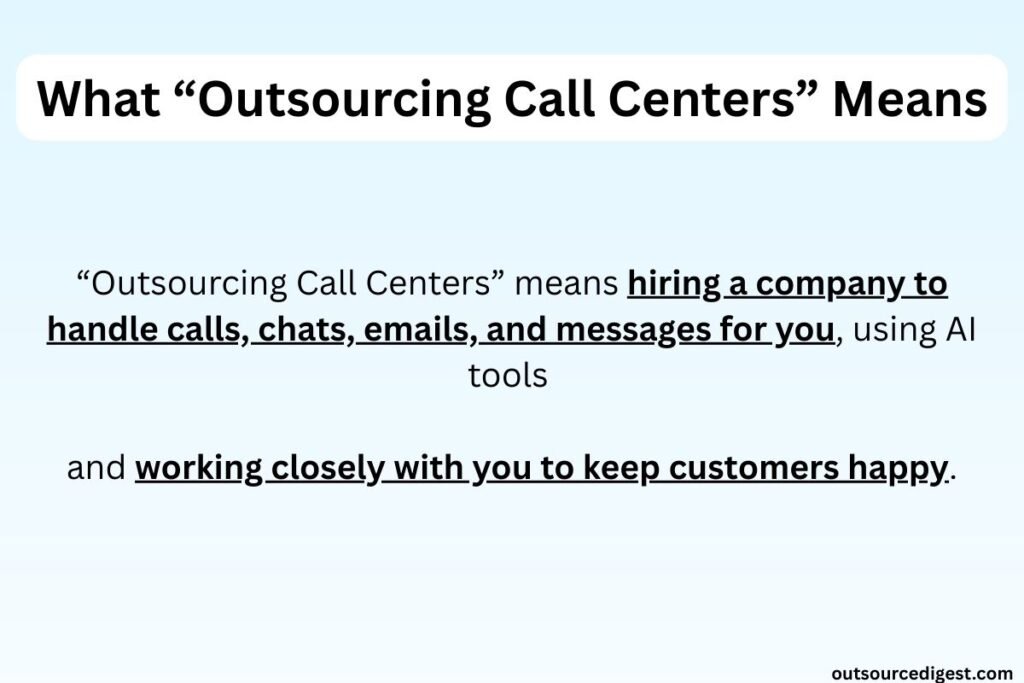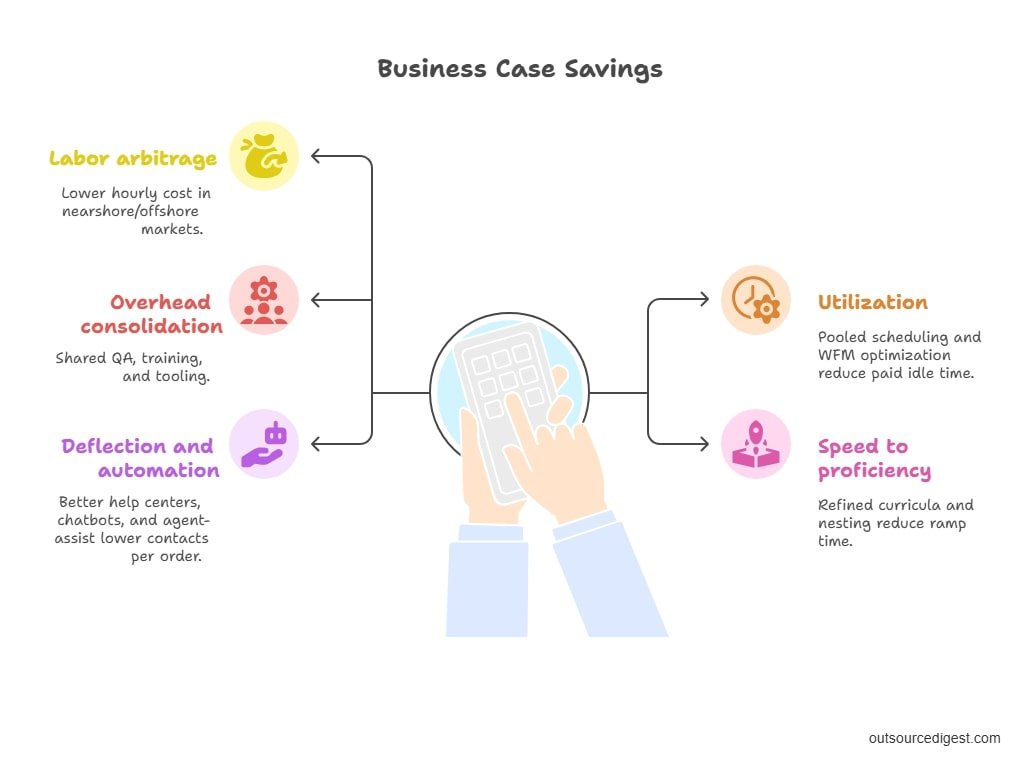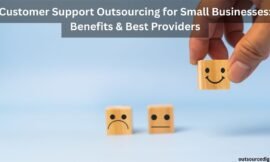US businesses entered 2025 under pressure to do more with less—fewer people, tighter budgets, and higher customer expectations across phone, chat, email, and social. As a result, a growing number of companies that outsource call centers are shifting from in-house teams to specialized call center outsourcing companies. The goal is not only to save money; it’s also to unlock 24/7 coverage, multilingual talent, and mature quality programs that reduce churn and lift lifetime value.
This growing shift also connects directly to the challenges faced by small businesses. As highlighted in our guide on customer support outsourcing for small businesses, outsourcing is not just a cost-cutting tactic—it’s a way for smaller companies to access professional support teams, scale coverage, and meet rising customer expectations without overstretching internal resources.
In the following sections, we’ll break down why call center outsourcing accelerated in 2025, the benefits and risks to consider, and how to select a partner that truly fits your brand.
What “Outsourcing Call Centers” Really Means in 2025

Outsourcing used to mean handing off phone calls to a third party. Now, it often covers an omnichannel operation that blends voice, live chat, in-app messaging, email, social DMs, and even SMS. Leading vendors run cloud contact center platforms, integrate with your CRM, and apply AI for routing, agent assistance, and quality. Importantly, the best call center outsourcing companies build playbooks with your team, measure customer sentiment, and iterate weekly—not yearly.
Why More US Companies Are Outsourcing
- Cost Control Without Downgrading CX
Wage inflation, benefits, and management overhead make internal call centers expensive. Outsourcing converts fixed costs to variable ones and spreads training, QA, WFM (workforce management), and tooling across many clients. Consequently, companies can reallocate spend to growth and product while keeping service levels steady—or better.
- On-Demand Scale for Peaks
Seasonal spikes, product launches, or outages can overwhelm in-house teams. Outsourcers maintain talent pools and cross-trained agents, so they staff up quickly, then scale down as volume normalizes. This elasticity helps companies that outsource call centers avoid long queues, missed SLAs, and overtime burn.
- Follow-the-Sun Coverage
Customers expect answers at 2 a.m. just as much as 2 p.m. Multi-site providers stitch together US, nearshore, and offshore locations to deliver genuine 24/7 support without graveyard shifts. As a result, brands improve first-response time and boost CSAT while keeping managers sane.
- Access to Specialized Talent
Technical support, healthcare compliance, fintech KYC, or retail returns—each requires different skill sets. Mature call center outsourcing companies recruit for niche programs daily, run academies, and keep bench strength for niche languages like Canadian French or Brazilian Portuguese. Your recruiting team no longer has to hunt for unicorns.
- Better Tooling, Faster
Vendors live inside contact center platforms: CCaaS routing, real-time transcription, agent-assist copilots, knowledge bases, and QA automation. Because they deploy at scale, they roll out updates and optimizations faster than many in-house teams can. You benefit from proven workflows and a shorter time-to-value.
- Compliance and Risk Management
From PCI and HIPAA to SOC 2, the overhead is real. Reputable providers invest in physical security, endpoint controls, and audit programs. For regulated industries, this removes friction and shortens procurement cycles—another reason companies that outsource call centers keep growing in 2025.
Nearshore, Offshore, or Onshore? The 2025 Location Mix
Onshore (US-based): Highest cost, closest cultural alignment, strongest data residency guarantees. Ideal for complex cases, sensitive data, or high-value customers.
Nearshore (e.g., Mexico, Colombia, Costa Rica): Short flights, overlapping time zones, strong English proficiency, and competitive pricing. Many US brands pick nearshore for voice and back-office work that needs real-time collaboration.
Offshore (e.g., the Philippines, India, South Africa): Deep talent pools, strong process maturity, and the most aggressive pricing. Great for 24/7 coverage, email/chat queues, and large seasonal ramps.
Most 2025 programs use a hybrid model—tier 1 in nearshore/offshore for scale and tier 2/retention work onshore for nuance and upsell.
What “Good” Looks Like: Outcomes You Should Demand
- Faster Resolution With Zero Guesswork
Expect strong first-contact resolution (FCR), not just shorter handle time. Good partners use searchable knowledge bases, dynamic scripts, and escalation trees. They coach agents weekly with call snippets and real examples, not generic lectures.
- Consistent Customer Experience Across Channels
The same tone and answers—phone, chat, email, and social. Leading vendors build a brand style guide and enforce it with QA scorecards. They track sentiment and effort score, then fix friction in the journey, not only in the call.
- Transparent Metrics You Can Trust
Look for live dashboards with queue health, SLA attainment, FCR, transfers, AHT, NPS/CSAT, and QA outcomes. Moreover, insist on weekly ops reviews and a monthly business review with insights, not just numbers.
The Business Case: Where Savings and Value Come From
You don’t need to anchor on one number to see the logic. Savings typically come from:

- Labor arbitrage: lower hourly cost in nearshore/offshore markets.
- Utilization: Pooled scheduling and WFM optimization reduce paid idle time.
- Overhead consolidation: shared QA, training, and tooling.
- Speed to proficiency: refined curricula and nesting reduce ramp time.
- Deflection and automation: better help centers, chatbots, and agent-assist lower contacts per order.
However, the bigger win often shows up in revenue: faster replies reduce cancellations, thoughtful save-the-sale scripts protect subscriptions, and proactive engagement increases lifetime value.
Common Objections—And Practical Answers
- “We’ll lose control of our brand.”
You keep control by setting a clear brand voice, approving scripts, and joining calibration sessions. Great partners welcome shadowing, side-by-sides, and joint QA.
- “Quality will drop.”
It drops only when programs lack governance. Create a shared scorecard, monitor 100% of interactions with AI, and review a real sample weekly. Quality usually improves because specialists run the playbook daily.
- “Security worries me.”
Choose SOC 2-audited vendors with role-based access, SSO, DLP, and clean desk policies. Keep sensitive workflows onshore if needed and tokenize payment data.
- “Hidden fees will appear.”
Write unit rates and out-of-scope items into the MSA. Ask for an implementation fee cap and a clear change-request process.
How to Choose Call Center Outsourcing Companies (A Buyer’s Checklist)
- Domain expertise: Do they have case studies in your vertical? Can they show quality metrics and before/after?
- Channel coverage: Voice, chat, email, social, and SMS with unified reporting.
- Talent strategy: Hiring funnels, language testing, and nesting plans.
- Training & QA: Curriculum, frequency of coaching, AI-assisted QA, and calibration cadence.
- Tech stack: CCaaS, CRM integration, agent-assist, WFM, and analytics.
- Security & compliance: Audits, certifications, data residency, and vendor risk processes.
- Scaling track record: Ramps they’ve delivered (size, speed, outcomes).
- Cultural alignment: Accent neutrality for voice, empathy for your audience, and brand tone.
- Commercials: Transparent pricing, SLAs tied to credits, and clear exit terms.
- References: Speak to two clients who launched in the last 12 months.
Implementation Roadmap: From Decision to “Live” in 90 Days
During weeks 1–2, the focus is on Discovery & Design:
- Define goals (e.g., reduce first response time from X to Y, hit 90% SLA).
- Share volumes by channel, contact reasons, and current macros.
- Map escalation paths and data access needs.
From weeks 3–5, the team works to Build & Integrate:
- Connect CCaaS/CRM, set up queues, and import knowledge content.
- Finalize scripts, style guide, and QA scorecard.
- Recruit agents; confirm language and technical skills.
In weeks 6–8, efforts shift toward Training & Piloting:
- Run training, nesting, and side-by-sides.
- Launch a limited pilot (one channel or one product line).
- Hold daily stand-ups; fix issues immediately.
Finally, weeks 9–12 are dedicated to Scaling & Stabilizing:
- Expand to full volume.
- Start weekly ops reviews and monthly business reviews.
- Launch continuous improvement (deflection, macros, and root-cause fixes).
KPIs That Matter (and How to Avoid Vanity Metrics)
- Service Level (e.g., 80/20 or your target): shows queue health; don’t chase it at the expense of quality.
- First-Contact Resolution: prevents repeat contacts; tie bonuses to it.
- Customer Effort Score & CSAT: track by channel and reason code.
- AHT with Context: shorter is not always better—optimize for resolution and sentiment.
- Transfer & Escalation Rate: Keep ownership with the first agent where possible.
- QA Score: align rubric to brand voice, compliance, and empathy.
- Revenue Save/Upsell: for subscriptions and retail, measure saves and assisted conversions.
When You Should Not Outsource (Yet)
- Your product is still pivoting weekly, and documentation lags behind.
- You have no clear escalation path or CRM hygiene.
- You can’t share the data or tooling that a vendor needs to help customers.
Fix the basics first; then a partner can add real leverage.
Real-World Use Cases
- SaaS scale-up
- Moved chat and email to a nearshore team while keeping complex enterprise tickets onshore.
- Result: faster first response and fewer weekend backlogs.
- DTC retailer
- Added offshore voice for order status and returns, with onshore social DMs for brand tone.
- Result: higher CSAT during peak season without hiring 100 temps.
- Fintech
- Kept KYC onshore for compliance but used offshore back-office for verifications.
- Result: shorter account approval times and better audit trails.
These patterns echo why companies that outsource call centers keep multiplying in 2025: they can mix locations and channels to match risk, cost, and brand voice.
How to Brief an RFP the Smart Way

- Define the job to be done: contact reasons by percentage, not assumptions.
- Share real samples: five anonymized tickets per reason code.
- Ask for a staffing plan: ramp timeline, nesting approach, supervisor ratios.
- Request a quality plan: rubrics, calibration schedule, and sample coaching notes.
- Demand a transition plan: knowledge base migration, macros, and change control.
- Set outcome targets: SLA, FCR, CSAT, and improvement commitments by quarter.
Risks to Watch—and How to Mitigate Them
- Agent churn: Choose vendors with strong engagement, career paths, and coaching.
- Knowledge drift: Lock a cadence to update macros and KB articles monthly (or faster).
- Over-automation: Use bots for status checks and FAQs, but route complex issues to humans.
- Scope creep: Maintain a change log; price new work with mini SOWs, not hallway agreements.
- Cultural mismatch: Pilot voice programs with accent screening and role-plays.
With the right guardrails, call center outsourcing companies become an extension of your brand—not a cost center you tolerate.
FAQs (Quick Answers)
No. In 2025, the bigger wins are faster response, better coverage, and specialized talent that lifts retention and revenue.
Yes—if you pick a provider with the right certifications, access controls, and data residency options, and if you enforce them in your MSA.
Many vendors start with small teams (5–15 agents) and scale as volumes grow. Micro-programs can work if your workflows are clear and repeatable.
Start with the most standardized queues—status checks, returns, and password resets. Keep complex escalations in-house until your knowledge base is solid.
Conclusion
In 2025, outsourcing is less about handing off calls and more about orchestrating a high-performing, omnichannel customer experience. Companies that outsource call centers do it to control costs, yes, but also to gain elasticity, technology, and talent they can’t build fast enough internally. If you define outcomes, pick the right call center outsourcing companies, and run a disciplined launch, you’ll improve CX and protect margins at the same time.



